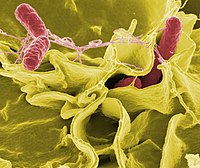
Photo from wikipedia
Introduction. Antimicrobial resistance (AMR) is a One Health issue concerning humans, animals and the environment and a unified One Health approach is required to contain this problematic issue. Dogs and… Click to show full abstract
Introduction. Antimicrobial resistance (AMR) is a One Health issue concerning humans, animals and the environment and a unified One Health approach is required to contain this problematic issue. Dogs and cats are popular pet animals and are known to carry many bacterial pathogens that are of public health importance, including Salmonella. However, data on AMR in companion animals is limited.Gap statement. Scant AMR data from bacteria originating from companion animals limits an accurate assessment of the impacts of pet-animal-related AMR on public health.Purpose. This study aimed to phenotypically and genetically investigate AMR in Salmonella isolated from pet dogs and cats in Thailand.Methodology. Salmonella enterica were isolated from pet dogs (n=159) and cats (n=19) in Thailand between 2016 and 2019. All isolates were serotyped. Phenotypic and genotypic antimicrobial resistance was examined. PCR-based replicon typing, replicon sequence typing and plasmid multilocus sequence typing were conducted to characterize plasmids.Results. Seventy-seven serovars were identified, with serovars Weltevreden (9.6%) and Stockholm (9.0%) the most common. Most of the isolates (34.3%) were multidrug-resistant. The serovar Stockholm was an ESBL-producer and carried the β-lactamase genes bla TEM-1 and bla CTX-M-55. The plasmid-mediated quinolone resistance (PMQR) gene, qnrS, was also detected (10.1%). Class 1 integrons carrying the dfrA12-aadA2 cassette array were most frequent (45.9%). Five plasmid replicon types as IncA/C (0.6%), N (1.1%), IncFIIA (28.7%), IncHI1 (2.2%), and IncI1 (3.4%) were identified. Based on the pMLST typing scheme (n=9), plasmids were assigned into five different STs including IncA/C-ST6 (n=1), IncH1-ST16 (n=4), IncI1-ST3 (n=1), IncI1-ST60 (n=1) and IncI1-ST136 (n=1). The ST 16 of IncHI1 plasmid was a novel plasmid ST. Subtyping F-type plasmids using the RST scheme (n=9) revealed four different combinations of replicons including S1:A-:B- (n=4), S1:A-:B22 (n=2), S3:A-:B- (n=1) and S-:A-:B47 (n=1).Conclusions. Our findings highlight the role of clinically healthy household dogs and cats as carriers of AMR Salmonella strains with different R plasmid. The implementation of AMR phenotypes instigation and genotypic monitoring and surveillance programmes in companion animals are imperative as integral components of the One Health framework.
Journal Title: Journal of medical microbiology
Year Published: 2022
Link to full text (if available)
Share on Social Media: Sign Up to like & get
recommendations!